Sedimentary Facies, Architectural Elements, and Depositional Environments of the Maastrichtian Pab Formation in the Rakhi Gorge, Eastern Sulaiman Ranges, Pakistan
Abstract
1. Introduction
2. Geological Setting
2.1. Stratigraphy of the Study Area
Pab Formation
3. Material and Methods
4. Results
4.1. Petrography
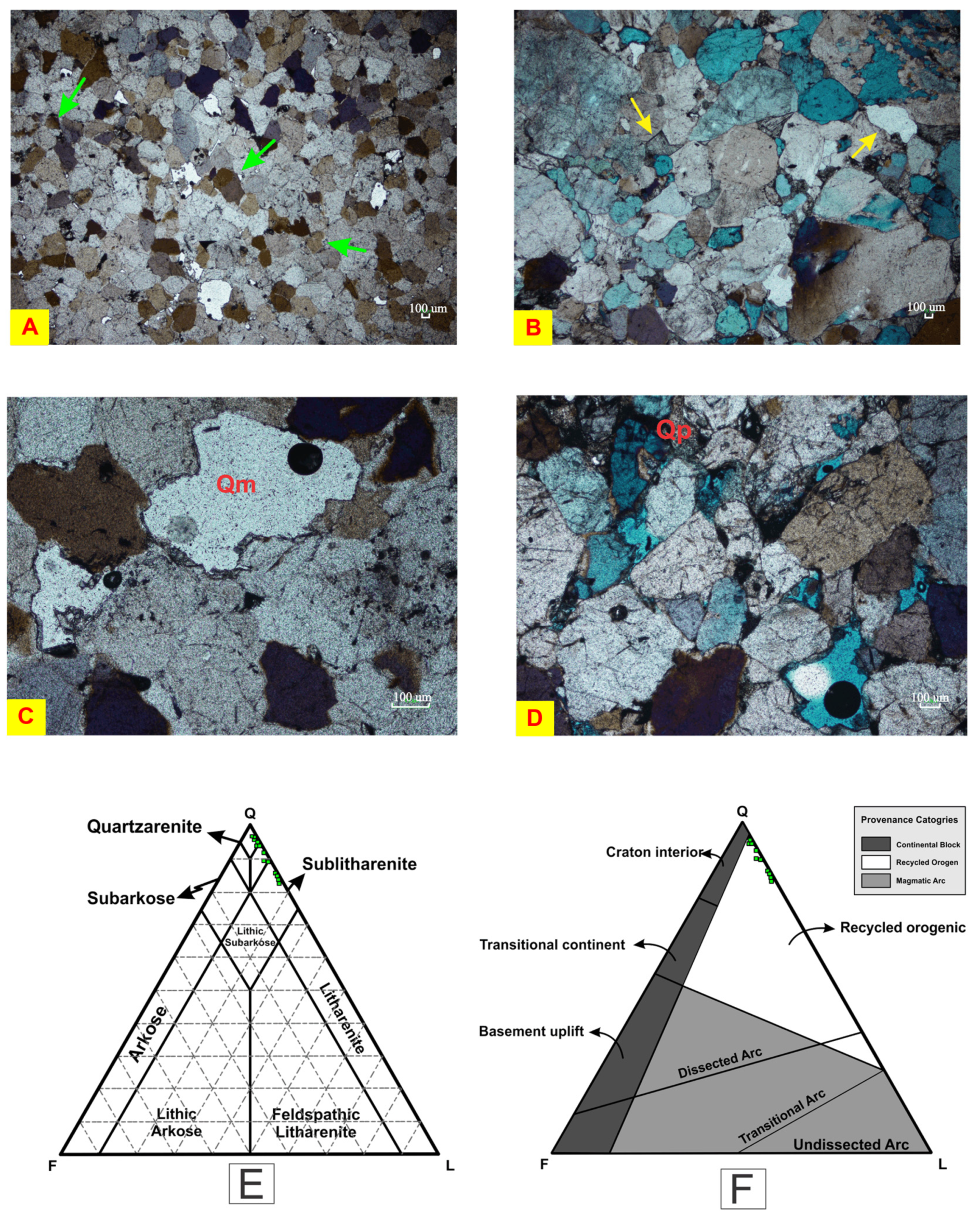
4.2. Lithofacies
4.2.1. Paleosol Facies (Pf)
4.2.2. Sandstone with Channel Deposit Facies (Sch)
4.2.3. Thin Bedded Claystone Facies (Cf)
4.2.4. Thin-Medium Bedded Shale Facies (Sh)
4.2.5. Thick Bedded Sandstone Facies (St)
4.2.6. Nodular Sandstone Facies (Sn)
4.2.7. Coarse Grained Sandstone with Planar Cross Beds Facies (Sp)
4.2.8. Coarse Grained Trough Cross Bedded Sandstone Facies (Stc)
4.2.9. Bioturbated, Trace Fossils Sandstone Facies (Sb)
4.3. Architectural Element Analysis
4.3.1. Planar Cross-Bedded Sandstone Element (Scp)
4.3.2. Trace Fossil-Sandstone Element (St)
4.3.3. Trough Cross-Bedded Sandstone Element (Sct)
4.3.4. Fine Sandstone Element (Sf)
4.3.5. Channel Deposit Element (Ch)
4.3.6. Laminated Shale Sheet Element (Ls)
4.3.7. Paleosol Element (Pa)
5. Discussion
5.1. Facies Association
5.1.1. Fluvio-Deltaic Facies Associations
5.1.2. Shelfal Delta Lobe Facies Association
5.1.3. Delta Front Facies Association
5.1.4. Channels Facies Association
5.1.5. Shore Face Facies Association
5.2. Depositional Model
6. Conclusions
Author Contributions
Funding
Institutional Review Board Statement
Informed Consent Statement
Data Availability Statement
Acknowledgments
Conflicts of Interest
References
- Ali, S.K.; Janjuhah, H.T.; Shahzad, S.M.; Kontakiotis, G.; Saleem, M.H.; Khan, U.; Zarkogiannis, S.D.; Makri, P.; Antonarakou, A. Depositional Sedimentary Facies, Stratigraphic Control, Paleoecological Constraints, and Paleogeographic Reconstruction of Late Permian Chhidru Formation (Western Salt Range, Pakistan). J. Mar. Sci. Eng. 2021, 9, 1372. [Google Scholar] [CrossRef]
- Ghazi, S.; Mountney, N.P. Facies and architectural element analysis of a meandering fluvial succession: The Permian Warchha Sandstone, Salt Range, Pakistan. Sediment. Geol. 2009, 221, 99–126. [Google Scholar] [CrossRef]
- Miall, A. The Geology of Fluvial Sediments; Springer: Berlin, Germany, 1996. [Google Scholar]
- Zang, D.; Bao, Z.; Li, M.; Fu, P.; Li, M.; Niu, B.; Li, Z.; Zhang, L.; Wei, M.; Dou, L.; et al. Sandbody architecture analysis of braided river reservoirs and their significance for remaining oil distribution: A case study based on a new outcrop in the Songliao Basin, Northeast China. Energy Explor. Exploit. 2020, 38, 2231–2251. [Google Scholar] [CrossRef]
- Khan, M.; Ghazi, S.; Mehmood, M.; Yazdi, A.; Naseem, A.A.; Serwar, U.; Zaheer, A.; Ullah, H. Sedimentological and provenance analysis of the Cretaceous Moro formation Rakhi Gorge, Eastern Sulaiman Range, Pakistan. Iran. J. Earth Sci. 2021, 13, 251–265. [Google Scholar]
- Euzen, T.; Eschard, R.; Albouy, E.; Deschamps, R. Reservoir architecture of a turbidite channel complex in the Pab Formation, Pakistan; AAPG Studies in Geology 56: Atlas of Deep-Water Outcrops: Tulsa, OK, USA, 2007; Chapter 139. [Google Scholar] [CrossRef]
- Mehmood, M.; Ghazi, S.; Naseem, A.A.; Yaseen, M.; Dar, Q.U.Z.; Khan, M.J.; Sarwar, U.; Zaheer, A. Petrofacies investigations of the Cretaceous Pab Formation Rakhi Gorge Eastern Sulaiman Range Pakistan—Implication for reservoir potential. Bull. Geol. Soc. Malays. 2021, 72, 37–46. [Google Scholar] [CrossRef]
- Umar, M.; Friis, H.; Khan, A.S.; Kassi, A.M.; Kasi, A.K. The effects of diagenesis on the reservoir characters in sandstones of the Late Cretaceous Pab Formation, Kirthar Fold Belt, southern Pakistan. J. Asian Earth Sci. 2011, 40, 622–635. [Google Scholar] [CrossRef]
- Reynolds, K.; Copley, A.; Hussain, E. Evolution and dynamics of a fold-thrust belt: The Sulaiman Range of Pakistan. Geophys. J. Int. 2015, 201, 683–710. [Google Scholar] [CrossRef]
- Stein, S.; Sella, G.; Okal, E.A. The January 26, 2001 Bhuj Earthquake and the Diffuse Western Boundary of the Indian Plate, in Plate Boundary Zones; AGU: Washington, DC, USA, 2002; pp. 243–254. [Google Scholar]
- Szeliga, W.; Bilham, R.; Kakar, D.M.; Lodi, S.H. Interseismic strain accumulation along the western boundary of the Indian subcontinent. J. Geophys. Res. Atmos. 2012, 117. [Google Scholar] [CrossRef]
- Vernant, P.; Nilforoushan, F.; Hatzfeld, D.; Abbassi, M.R.; Vigny, C.; Masson, F.; Nankali, H.; Martinod, J.; Ashtiani, A.; Bayer, R.; et al. Present-day crustal deformation and plate kinematics in the Middle East constrained by GPS measurements in Iran and northern Oman. Geophys. J. Int. 2004, 157, 381–398. [Google Scholar] [CrossRef]
- Kassi, A.M.; Kelling, G.; Kasi, A.K.; Umar, M.; Khan, A.S. Contrasting Late Cretaceous–Palaeocene lithostratigraphic successions across the Bibai Thrust, western Sulaiman Fold–Thrust Belt, Pakistan: Their significance in deciphering the early-collisional history of the NW Indian Plate margin. J. Asian Earth Sci. 2009, 35, 435–444. [Google Scholar] [CrossRef]
- Ghazi, A.; Hafezi Moghadas, N.; Sadeghi, H.; Ghafoori, M.; Lashkaripour, G. The effect of geomorphology on engineering geology properties of alluvial deposits in Mashhad City. Sci. Q. J. Geosci. 2015, 24, 17–28. [Google Scholar]
- Vredenburg, E.W. Report on the Geology of Sarawan, Jhalawan, Mekran and the State of Las Bela, Considered Principally from the Point of View of Economic Development. Rec. Geol. Surv. India 1909, 3, 189–215. [Google Scholar]
- Miall, A.D. Facies architecture in clastic sedimentary basins. In New Perspectives in Basin Analysis; Springer: New York, NY, USA, 1988; pp. 67–81. [Google Scholar]
- Miall, A.D. In defense of facies classifications and models. J. Sediment. Res. 1999, 69, 2–5. [Google Scholar] [CrossRef]
- Miall, A.D. Fluvial Depositional Systems; Springer International Publishing: Cham, Switzerland, 2014; Volume 14, p. 316. [Google Scholar]
- Farrell, K.M.; Harris, W.B.; Mallinson, D.J.; Culver, S.J.; Riggs, S.R.; Pierson, J.; Self-Trail, J.M.; Lautier, J.C. Standardizing Texture and Facies Codes for A Process-Based Classification of Clastic Sediment and Rock. J. Sediment. Res. 2012, 82, 364–378. [Google Scholar] [CrossRef]
- Dickinson, W.R. Interpreting Provenance Relations from Detrital Modes of Sandstones. In Provenance of Arenites; Springer: Dordrecht, The Netherlands, 1985; pp. 333–361. [Google Scholar] [CrossRef]
- Ghazi, S.; Mountney, N.P.; Sharif, S. Lower Permian fluvial cyclicity and stratigraphic evolution of the northern margin of Gondwanaland: Warchha Sandstone, Salt Range, Pakistan. J. Asian Earth Sci. 2015, 105, 1–17. [Google Scholar] [CrossRef]
- McBride, E.F. A Classification of Common Sandstones. J. Sediment. Res. 1963, 33. [Google Scholar] [CrossRef]
- Miall, A.D. Architectural-element analysis: A new method of facies analysis applied to fluvial deposits. Earth-Sci. Rev. 1985, 22, 261–308. [Google Scholar] [CrossRef]
- Gustavson, T.C. Arid Basin Depositional System and Paleosol: Fort Hancock and Camp Rice Formation (Pliocene-Pleistocene), Hueco Bolson, West Texas and adjacent Mexico; Report of Investigation; Bureau of Economic Geology, Exploration Way: Austin, TX, USA, 1991; p. 198. [Google Scholar]
- Retallack, G.J. Scoyenia burrows from Ordovician palaeosols of the Juniata Formation in Pennsylvania. Palaeontology 2001, 44, 209–235. [Google Scholar] [CrossRef]
- Li, J.; Wen, X.; Huang, C. Lower Cretaceous paleosols and paleoclimate in Sichuan Basin, China. Cretac. Res. 2016, 62, 154–171. [Google Scholar] [CrossRef]
- Tabor, N.J.; Myers, T.S.; Michel, L.A. Sedimentologist’s guide for recognition, description, and classification of paleosols. In Terrestrial Depositional Systems; Elsevier: Amsterdam, The Netherlands, 2017; pp. 165–208. [Google Scholar]
- Malaza, N.; Liu, K.; Zhao, B. Facies Analysis and Depositional Environments of the Late Palaeozoic Coal-Bearing Madzaringwe Formation in the Tshipise-Pafuri Basin, South Africa. ISRN Geol. 2013, 2013, 120380. [Google Scholar] [CrossRef]
- Mayall, M.; Jones, E.; Casey, M. Turbidite channel reservoirs—Key elements in facies prediction and effective development. Mar. Pet. Geol. 2006, 23, 821–841. [Google Scholar] [CrossRef]
- Schumm, S.A. Evolution and Response of the Fluvial System, Sedimentologic Implications; SEPM: Broken Arrow, OK, USA, 1981; pp. 19–29. [Google Scholar] [CrossRef]
- Allen, J.R.L. Studies in fluviatile sedimentation: A comparison of fining upwards cyclothems, with particular reference to coarse member composition and interpretation. J. Sediment. Petrol. 1970, 40, 298–323. [Google Scholar]
- Collinson, J.D. Alluvial Sediments, In Sedimentary Environments and Facies, 3rd ed.; Reading, H.G., Ed.; Blackwell Publishing: Oxford, UK, 1996; pp. 37–82. [Google Scholar]
- Jackson II, R.G. Sedimentology of muddy fine-grained channel deposits in meandering streams of the American Middle West. J. Sediment. Petrol. 1981, 51, 1169–1192. [Google Scholar]
- Hjellbakk, A. Facies and fluvial architecture of a high-energy braided river: The Upper Proterozoic Seglodden Member, Varanger Peninsula, northern Norway. Sediment. Geol. 1997, 114, 131–161. [Google Scholar] [CrossRef]
- Ghazi, S.; Mountney, N.P. Subsurface lithofacies analysis of the fluvial early permian Warchha Sandstone, Potwar Basin, Pakistan. J. Geol. Soc. India 2010, 76, 505–517. [Google Scholar] [CrossRef]
- Walker, R.G. Facies models and modern stratigraphic concepts. In Facies Models: Response to Sea-level Change; Walker, R.G., James, N.P., Eds.; Geological Asociation of Canada: St. John’s, NL, Canada, 1992; pp. 1–14. [Google Scholar]
- Kingsley, C.S. Stratigraphy and Sedimentology of the Ecca Group in the Eastern Cape Province, South Africa. Ph.D. Thesis, University of Port Elizabeth, Port Elizabeth, South Africa, 1977; p. 290. [Google Scholar]
- Jamil, M.; Siddiqui, N.A.; Rahman, A.H.B.A.; Ibrahim, N.A.; Ismail, M.S.B.; Ahmed, N.; Usman, M.; Gul, Z.; Imran, Q.S. Facies Heterogeneity and Lobe Facies Multiscale Analysis of Deep-Marine Sand-Shale Complexity in the West Crocker Formation of Sabah Basin, NW Borneo. Appl. Sci. 2021, 11, 5513. [Google Scholar] [CrossRef]
- Bhattacharya, J.P.; Miall, A.D.; Ferron, C.; Gabriel, J.; Randazzo, N.; Kynaston, D.; Jicha, B.R.; Singer, B.S. Time-stratigraphy in point sourced river deltas: Application to sediment budgets, shelf construction, and paleo-storm records. Earth Sci. Rev. 2019, 199, 102985. [Google Scholar] [CrossRef]
- Arnot, M.J.; Browne, G.H.; King, P.R. Thick-bedded Sandstone Facies in a Middle Basin-floor-fan Setting; Mount Messenger Formation: Mohakatino Beach, New Zealand, 2007. [Google Scholar]
- Jones, B.G.; Rust, B.R. Massive sandstone facies in the Hawkesbury Sandstone, a Triassic fluvial deposit near Sydney, Australia. J. Sediment. Res. 1983, 53, 1249–1259. [Google Scholar]
- Fisher, W.L.; Galloway, W.E.; Steel, R.J.; Olariu, C.; Kerans, C.; Mohrig, D. Deep-water depositional systems supplied by shelf-incising submarine canyons: Recognition and significance in the geologic record. Earth Sci. Rev. 2021, 214, 103531. [Google Scholar] [CrossRef]
- Stow, D.A.; Hernández-Molina, F.J.; Llave, E.; Sayago-Gil, M.; Del Río, V.D.; Branson, A. Bedform-velocity matrix: The estimation of bottom current velocity from bedform observations. Geology 2009, 37, 327–330. [Google Scholar] [CrossRef]
- Selim, S.; El-Gwad, M.A.; Abu Khadrah, A. Sedimentology, petrography, hydraulic flow units, and reservoir quality of the bayhead delta reservoirs: Late Messinian Qawasim formation, Nile Delta, Egypt. Mar. Pet. Geol. 2021, 130, 105125. [Google Scholar] [CrossRef]
- Boulesteix, K.; Poyatos-More, M.; Flint, S.S.; Hodgson, D.M.; Taylor, K.G.; Parry, G.R. Sedimentary facies and stratigraphic architecture of deep-water mudstones beyond the basin-floor fan sandstone pinchout. J. Sediment. Res. 2020, 90, 1678–1705. [Google Scholar] [CrossRef]
- Aigbadon, G.O.; Akakuru, O.C.; Chinyem, F.I.; Akudo, E.O.; Musa, K.O.; Obasi, I.A.; Overare, B.; Ocheli, A.; Sanni, Z.J.; Bala, J.A., II. Facies analysis and sedimentology of the Campanian–Maastrichtian sediments, southern Bida Basin, Nigeria. Carbonates Evaporites 2023, 38, 27. [Google Scholar] [CrossRef]
- Nichols, G. Sedimentology and Stratigraphy; John Wiley & Sons: Hoboken, NJ, USA, 2009. [Google Scholar]
- Finthan, B.; Mamman, Y.D. The lithofacies and depositional paleoenvironment of the Bima Sandstone in Girei and Environs, Yola Arm, Upper Benue Trough, Northeastern Nigeria. J. Afr. Earth Sci. 2020, 169, 103863. [Google Scholar] [CrossRef]
- Dar, Q.U.Z.; Renhai, P.; Ghazi, S.; Ahmed, S.; Ali, R.I.; Mehmood, M. Depositional facies and reservoir characteristics of the Early Cretaceous Lower Goru Formation, Lower Indus Basin Pakistan: Integration of petrographic and gamma-ray log analysis. Petroleum 2021. [Google Scholar] [CrossRef]
- Eschard, R.; Albouy, E.; Gaumet, F.; Ayub, A. Comparing basin floor fan versus slope fan depositional architecture in the Pab sandstone, Maastrichtian, Pakistan. Geol. Soc. Lond. Spec. Publ. 2002, 222, 159–185. [Google Scholar] [CrossRef]
- Wang, C.-Z.; Wang, J.; Hu, B.; Lu, X.-H. Trace fossils and sedimentary environments of the upper cretaceous in the Xixia Basin, Southwestern Henan Province, China. Geodin. Acta 2016, 28, 53–70. [Google Scholar] [CrossRef]
- Okoro, A.U.; Igwe, E.O.; Umo, I.A. Sedimentary facies, paleoenvironments and reservoir potential of the Afikpo Sandstone on Macgregor Hill area in the Afikpo Sub-basin, southeastern Nigeria. SN Appl. Sci. 2020, 2, 1–17. [Google Scholar] [CrossRef]
- Ali, S.; Gingras, M.K.; Wilson, B.; Winter, R.; Gunness, T.; Wells, M. The influence of bioturbation on reservoir quality: Insights from the Columbus Basin, offshore Trinidad. Mar. Pet. Geol. 2023, 147, 105983. [Google Scholar] [CrossRef]
- Stow, D.; Nicholson, U.; Kearsey, S.; Tatum, D.; Gardiner, A.; Ghabra, A.; Jaweesh, M. The Pliocene-Recent Euphrates river system: Sediment facies and architecture as an analogue for subsurface reservoirs. Energy Geosci. 2020, 1, 174–193. [Google Scholar] [CrossRef]
- Coronel, M.D.; Isla, M.F.; Veiga, G.D.; Mountney, N.P.; Colombera, L. Anatomy and facies distribution of terminal lobes in ephemeral fluvial successions: Jurassic Tordillo Formation, Neuquén Basin, Argentina. Sedimentology 2020, 67, 2596–2624. [Google Scholar] [CrossRef]
- Bjerstedt, T.W. Trace fossils from the early Mississippian price delta, southeast west Virginia. J. Paleontol. 1988, 62, 506–519. [Google Scholar]
- Amireh, B.; Schneider, W.; Abed, A. Fluvial-shallow marine-glaciofluvial depositional environments of the Ordovician System in Jordan. J. Asian Earth Sci. 2001, 19, 45–60. [Google Scholar] [CrossRef]
- Fielding, C.R. Upper flow regime sheets, lenses and scour fills: Extending the range of architectural elements for fluvial sediment bodies. Sediment. Geol. 2006, 190, 227–240. [Google Scholar] [CrossRef]
- Maceachern, J.A.; Pemberton, S.G. Ichnological Aspects of Incised-Valley Fill Systems from the Viking Formation of the Western Canada Sedimentary Basin, Alberta, Canada. In Incised-Valley Systems: Origin and Sedimentary Sequences; SEPM Society for Sedimentary Geology: Broken Arrow, OK, USA, 1994. [Google Scholar] [CrossRef]
- Boggs, S. Principles of Sedimentology and Stratigraphy; Pearson: London, UK, 2012. [Google Scholar]
- Abdel-Fattah, Z.A. Fluvial architecture of the Upper Cretaceous Nubia Sandstones: An ancient example of sandy braided rivers in central Eastern Desert, Egypt. Sediment. Geol. 2021, 420, 105923. [Google Scholar] [CrossRef]
- Capuzzo, N.; Wetzel, A. Facies and Basin architectural of the late Carboniferous Salvan-Dorenaz continental basin (western Alps, Switzerland/France). Sedimentology 2004, 51, 675–697. [Google Scholar] [CrossRef]
- Olsen, H. The architecture of a sandy braided-meandering river system: An example from the Lower Triassic Solling Formation (M. Buntsandstein) in W Germany. Geol. Rundsch. 1988, 77, 797–814. [Google Scholar] [CrossRef]
- Bordy, E.M.; Head, H.; Runds, M.J. Paleoenvironment and provenance in the early Cape Basin of southwest Gondwana: Sedimentology of the lower ORDOVICIAN Piekenierskloof Formation, Cape Supergroup, South Africa. S. Afr. J. Geol. 2016, 119, 399–414. [Google Scholar] [CrossRef]
- Cant, D.J.; Walker, R.G. Fluvial processes and facies sequences in the sandy braided South Saskatchewan River, Canada. Sedimentology 1978, 25, 625–648. [Google Scholar] [CrossRef]
- Kraus, M.J. Paleosols in clastic sedimentary rocks: Their geologic applications. Earth-Sci. Rev. 1999, 47, 41–70. [Google Scholar] [CrossRef]
- Wilding, L.P.; Tessier, D. Genesis of Vertisols: Shrinkswell Phenomena. In Vertisols: Their Distribution, Properties, Classification and Management; Wilding, L.P., Puentes, R., Eds.; Texas A&M University Publishing Center: College Station, TX, USA, 1988; pp. 55–81. [Google Scholar]
- Buol, S.W.; Southard, R.J.; Graham, R.C.; Mcdaniel, P.A. Soil Genesis and Classification, 5th ed.; Iowa State University Press: Ames, Lowa, 2003; 494p. [Google Scholar]
- Shahzad, A.; Tan, J.; Ahsan, S.A.; Abbasi, I.A.; Shahzad, S.M. Identification of Potential Hydrocarbon Source Rocks Using Biological Markers in the Kohat-Potwar Plateaus, North Pakistan. In Proceedings of the 2022 Goldschmidt Conference, Honolulu, HI, USA, 11–15 July 2022. [Google Scholar]
- Khan, S.; Nisar, U.B.; Ehsan, S.A.; Farid, A.; Shahzad, S.M.; Qazi, H.H.; Khan, M.J.; Ahmed, T. Aquifer vulnerability and groundwater quality around Brahma Bahtar lesser Himalayas Pakistan. Environ. Earth Sci. 2021, 80, 454. [Google Scholar] [CrossRef]
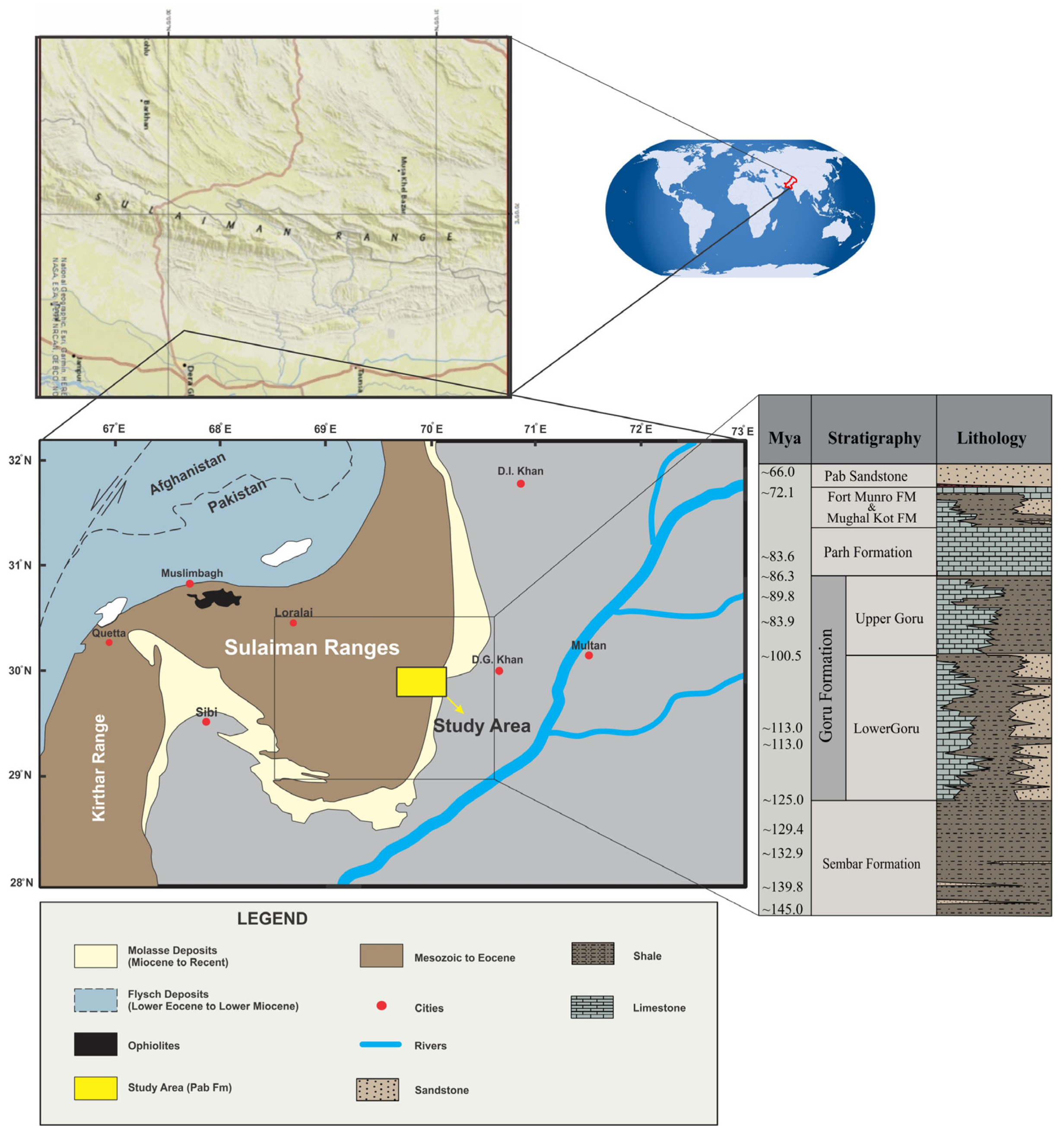
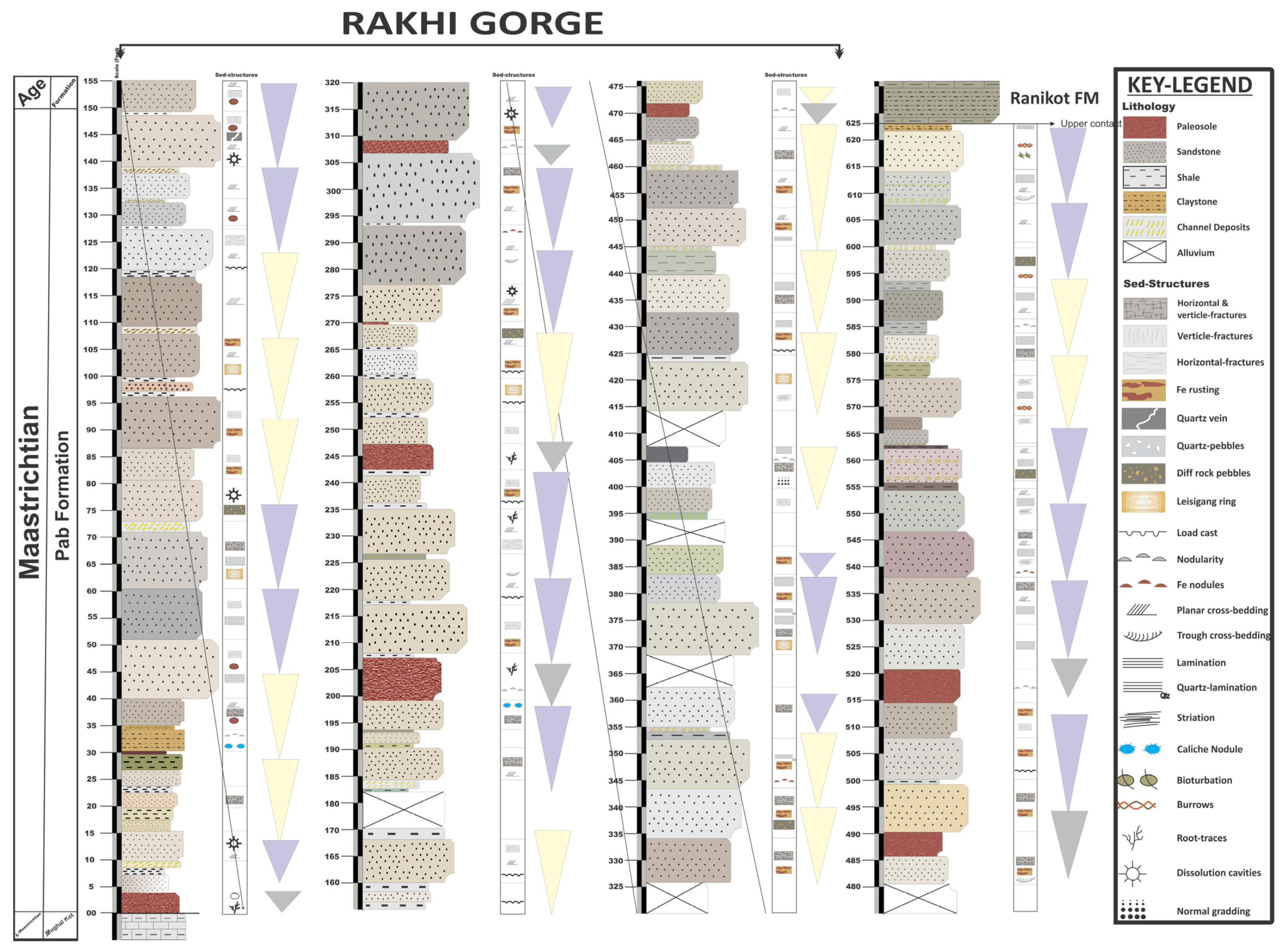
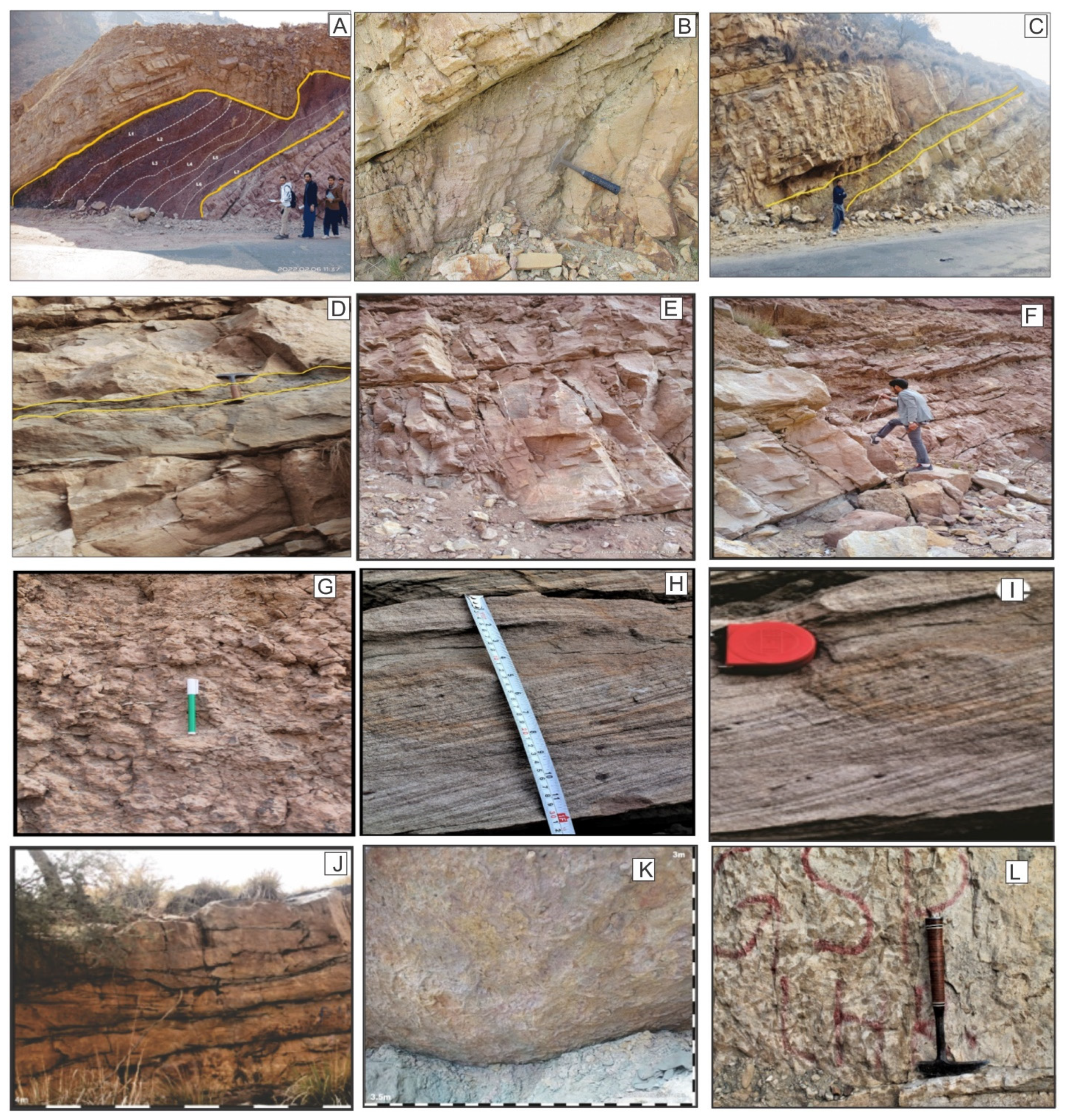
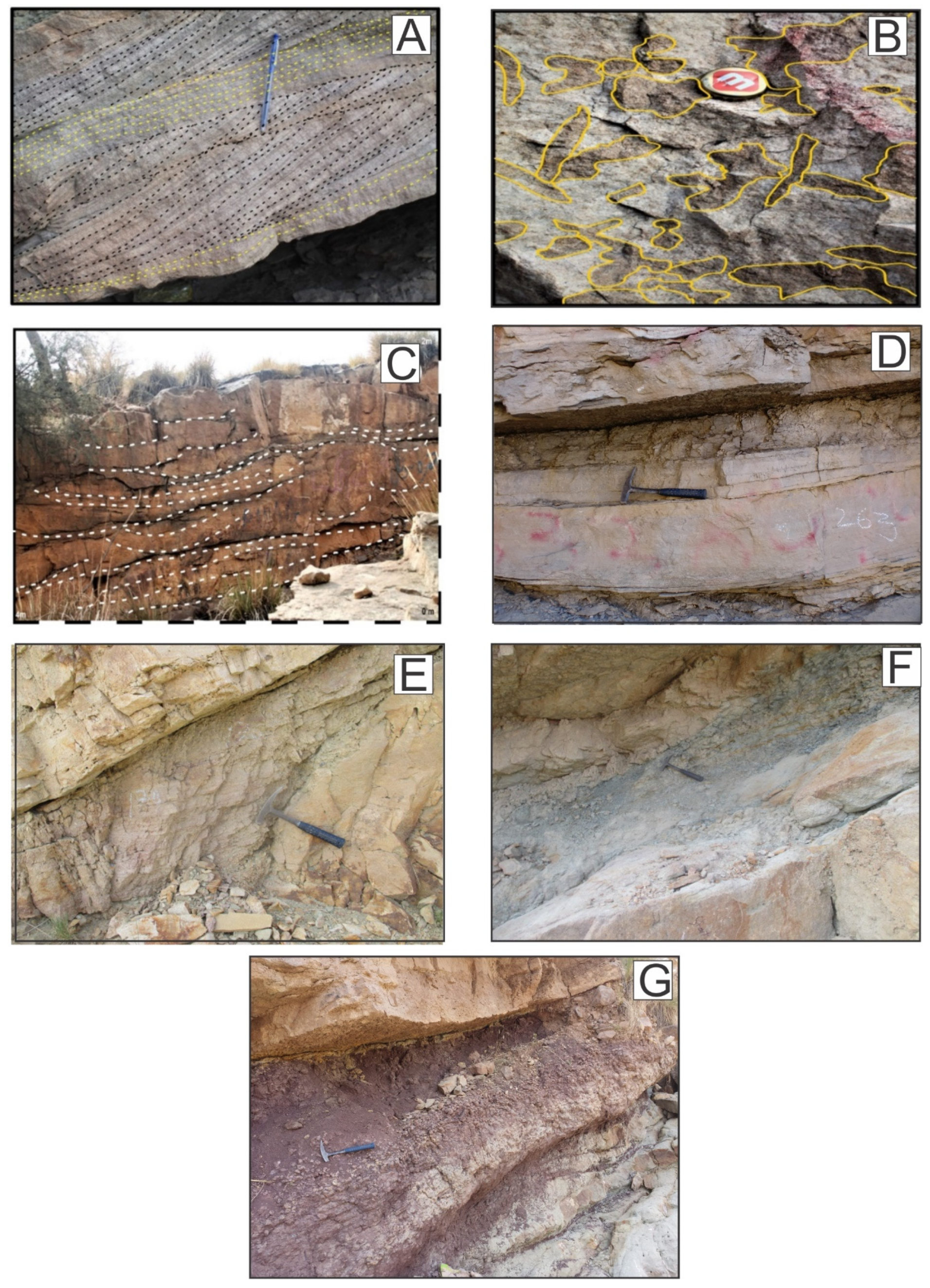
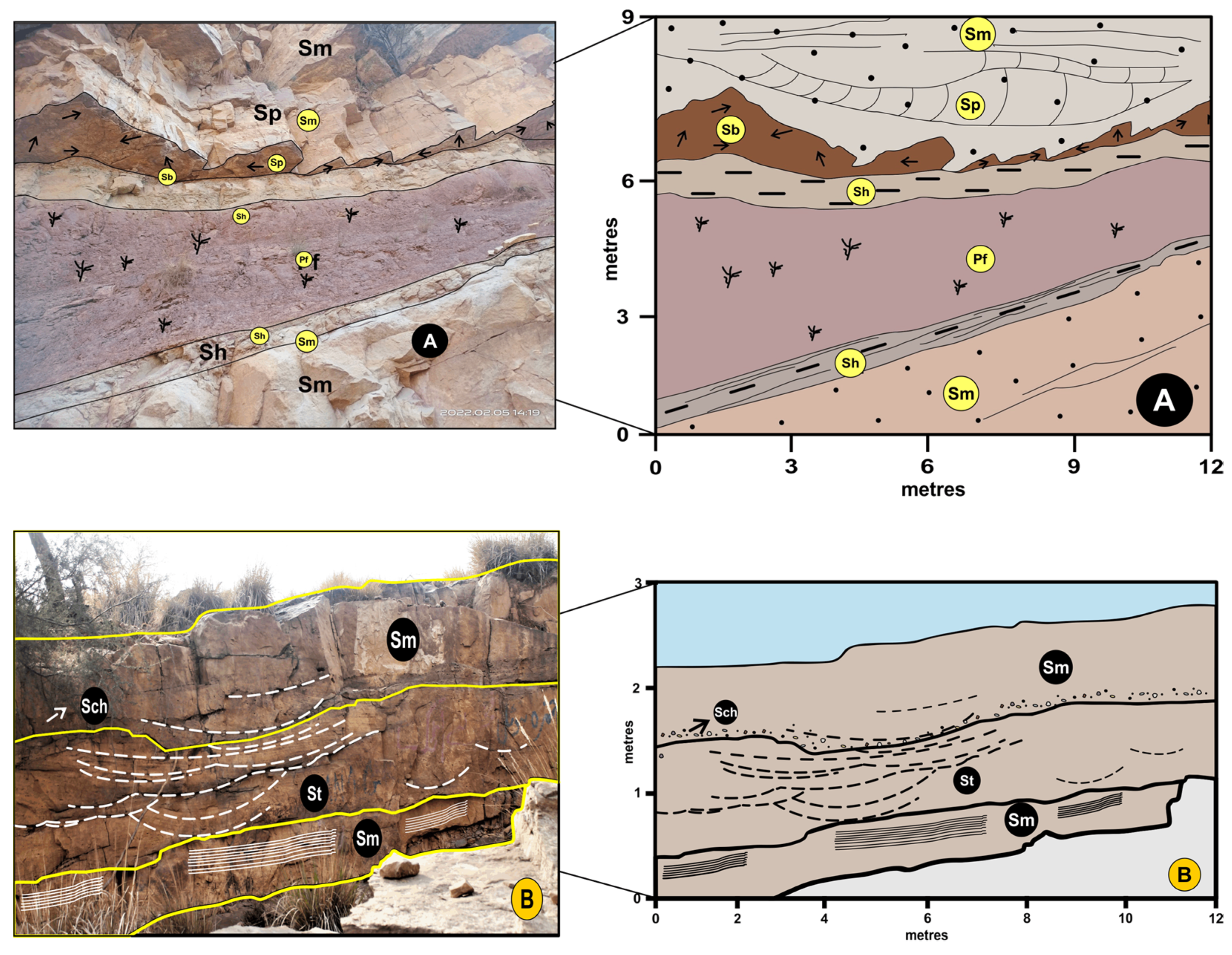
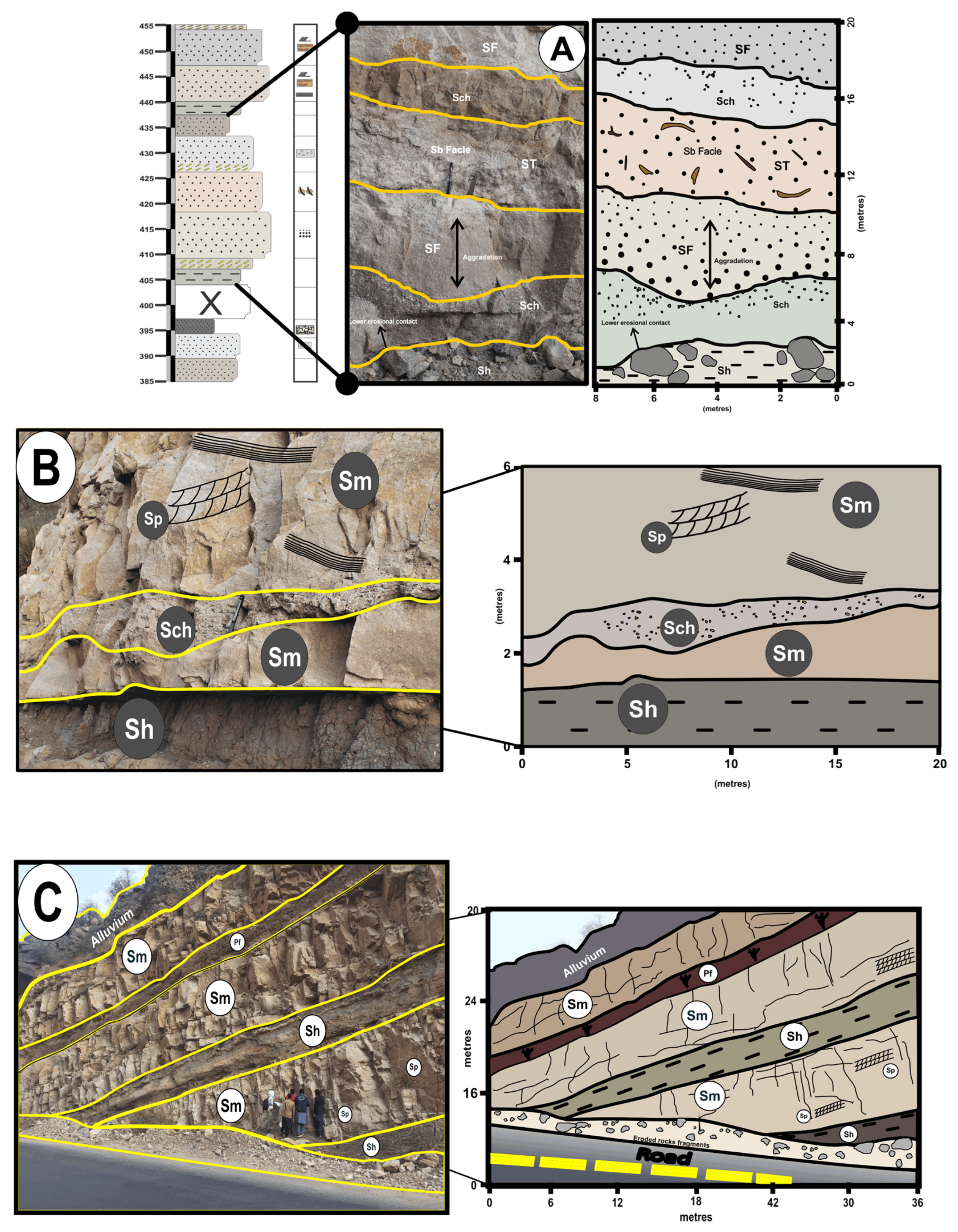
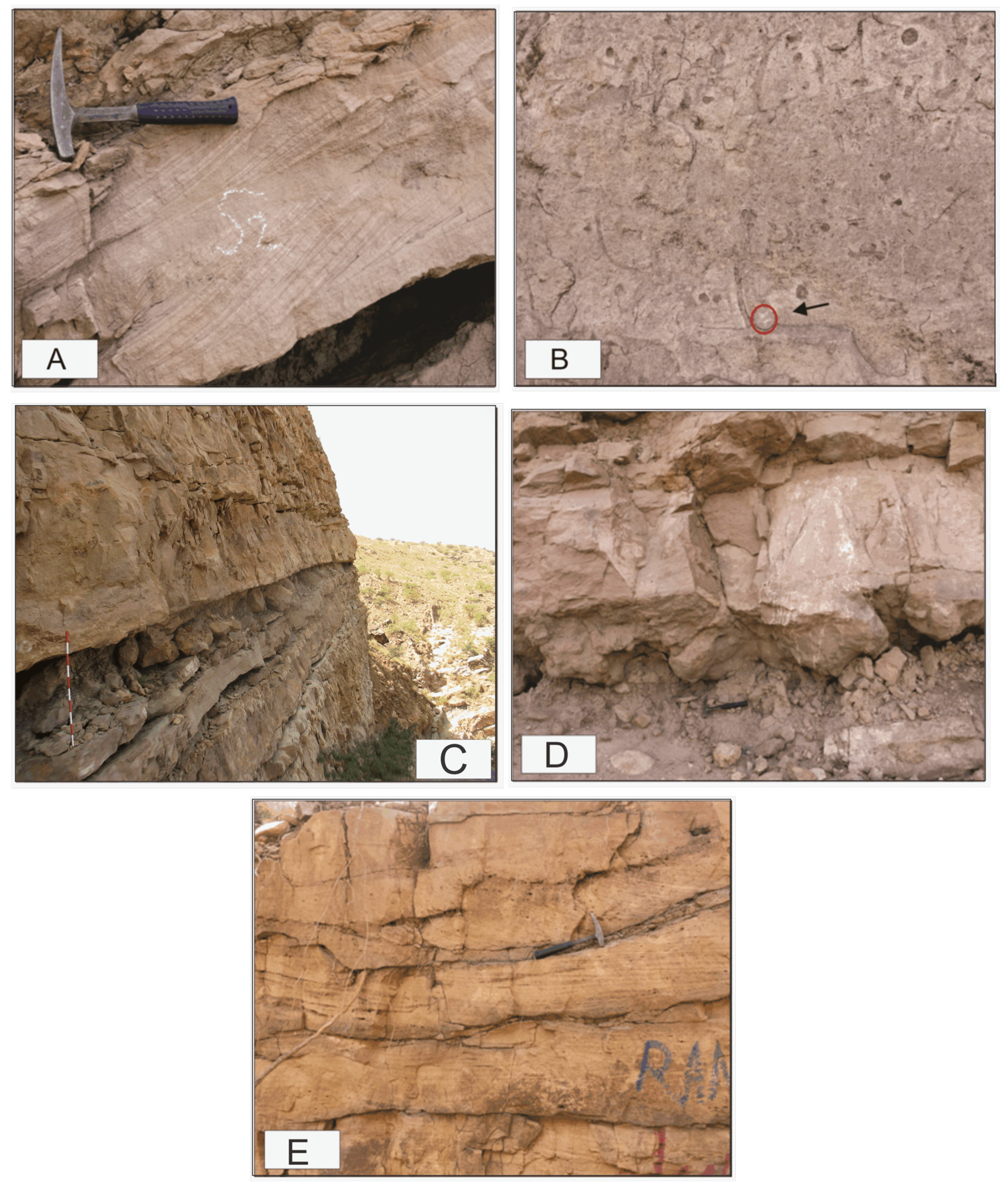
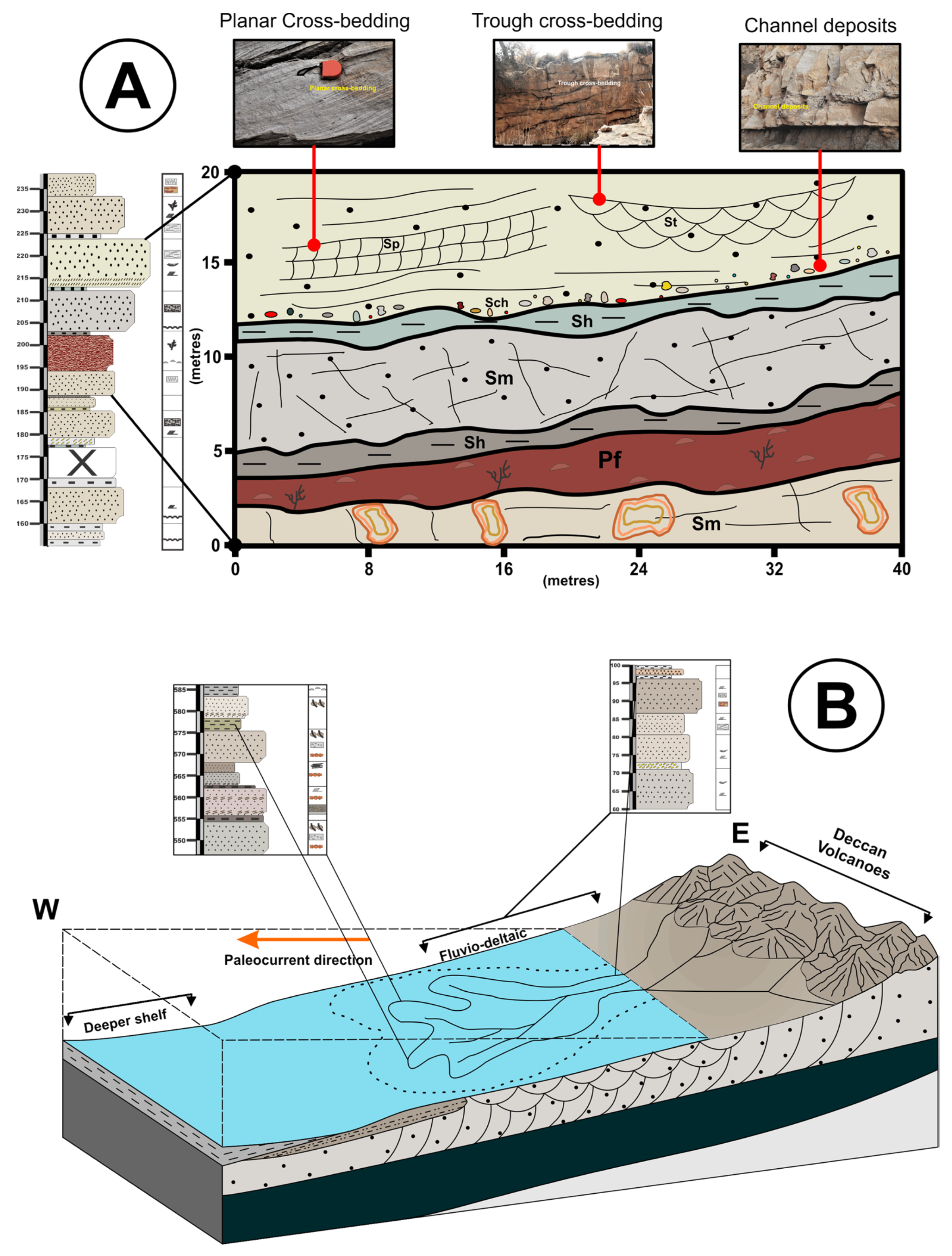
| Grain Size | Bed-Thickness | Sed-Structures | Description | Interpret-Ation | |
|---|---|---|---|---|---|
| 1. Paleosol Facies (Pf) | Fine soil | Thin to Thick bedded. From 0.30 m to 5.4 m. | Rootlets, Nodular Paleosol. | The Paleosol facies consists of fine-grained soil. The color of this facies is variable i.e., dark brown to rusty reddish, and in some places, the color is pale brown. Typically, the Paleosol are nodular and trace fossils of rootlets are found in this facies. | These lithofacies represents soil development in a humid climate. |
| 2. Sandstone with Channel Deposit Facies (Sch) | Coarse-grained sandstone, sand-gravel size in the channel deposits. | 0.08 m–0.16 m width and 8 m–10 m laterally extend along the beds | Channel deposits, Liesegang rings. | Channel deposits are in a layer and somewhere in the irregular form in the sandstone succession in the Pab Formation. It occurs at the base and also in the middle of sandstone beds. | Channel deposits indicate running water/Channel levee complex. |
| 3. Thin Bedded Clay stone Facies (Cf) | Very fine-grained clay. | Thin bedded, approximately 0.2 m to 0.4 m | None | The clay is almost sandy. The clay beds lie between the sandstone beds. The thickness of the clay beds is mostly thin-bedded. Color is varying, from med-brown-greyish to greenish-grey. | Suspension fall out/Flooding condition, overbank deposition. |
| 4. Thin-Medium Bedded Shale Facies (Sh) | Fine-grained sandy shale. | Thin to medium bedded. From 0.16 m up to 0.9 m. | Load cast, Fe rusting. | Thin-medium bedded shale b/w the. The color of the shale is from greenish-grey to pale yellowish and in some places, the color is light brown. | Deep to semi-deep sedimentary settings/overbank deposits/fills of floodplain-drainage channels |
| 5. Thick bedded Sandstone Facies (St) | Coarse to very coarse | 2.1 m to 3 m. | Planar cross-bedding, Trough cross-bedding, Liesegang rings, post deformational fractures. | Weathered color is mostly med-brown, med-greyish to med-yellowish, also pinkish beds are found. Mostly post deformational vertical and horizontal fractures. Also, iron rusting is common in Sm facies. | Delta lobe |
| 6. Nodular sandstone Beds Facies (Sn) | Med-coarse grain and nodules diameter is typically 4-2-4 cm. | 0.25 m to 0.7 m. | Nodularity/Chaotic nature | Nodular Sandstone is present. The Fe and chert nodules are common in this facies. color is med-brown to dark greyish brown. | Slumping/sudden fall out along the margins and slope and rapid deposition. |
| 7. Coarse-grained Sandstone with Planar Cross-Bedding Facies (Sp) | Coarse to very coarse-grained size. | 5 m to 2.5 m. | Planar cross-bedding, Liesegang rings. Irregular post deformational fractures. | Consists of coarse-grained sandstone with planar crossbedding. The weathered color is varied, from dark greyish to dark brown, and at some places, the color is pinkish, while the fresh color is off-white, light greyish to pale yellow and brown. | Shelfal delta lobe |
| 8. Coarse-grained Sandstone with Trough Cross-Bedding Facies (Stc) | Medium-coarse-grained sandstone. | 0.30 m–1 m. | Trough cross-bedding, post deformational horizontal and vertical fractures. | Med-Coarse grained sandstone with crossbedding. The weathered color is a pale yellow to brownish while the fresh color is light grey to off-white. | Shoreface facies |
| 9. Sandstone with bioturbation and Trace Fossils Facies (Sb) | Medium to coarse-grained. | 0.30 m to 1.5 m. | Trace fossils, Bioturbation, Fe rusting. | The color of this facies is from light brown and greyish to dark brown and greenish-grey. The bed’s thickness is about from 0.30 m to 1.5 m. The bioturbation occurs at the bottom of the sandstone beds. | Low-energy deltaic environment. |
| Element (Code) | Geometry | Facies Assoc. | Description | Interpretation |
|---|---|---|---|---|
| Planar Cross-Bedded Sandstone Element. (SCp) | Tabular, Sheet like | Sp Sm Sch | The SCp consisits of medium- to coarse-grained sandstone with planar cross-beds. They are pebbly and lenticular in nature. The planar cross-bedding sandstone element is abundant laterally and thegrain size of sandstone becomes finer in the upward side. They have a gradational contact with the lower beds. | The intercalation of coarse-grained sediments with the lithofacies Sp may reflect a rapid change in flood regime or imply high-energy sheet floods into a lower energy environment. |
| Traces-Sandstone Element. (ST) | Lobate and sheet-like | Sb Sp Sch | Medium to coarse-grained, lobate geometry of ST element. They are laterally extended up to 10 m and their average thickness is 1 m to 2 m. Their upper contact is flat but erosional with Sch facies. The common sedimentary structures found in element ST is traces of fossils. | The lobate geometry and traces of different fossils indicate in low-energy deltaic environment. |
| Trough Cross-Bedding Sandstone Element. (SCt) | Lenticular geometry. | St Stc Sch | Extended to the lower and central portion of the Formation. The trough cross-bedding element is found in medium to coarse-grained sandstone. Abundant trough cross bedding structures are commom. Low angle planar cross-bedding, and some minor fractures. | SCt is interpreted as the product of three-dimensional dunes migrating in channels under lower flow regime conditions. |
| Fined-Sandstone Element. (SF) | Sheet like | Sch Sp Sm | The SF element is fined-grained sandstone. SF deposits have a sheet-like geometry, reflecting their origin by vertical aggradation. Trace fossils are found in the SF element. | Sheet-like geometry, together with the small-scale sedimentary structures and the fine-grained lithology suggests deposition as a bar-top or bar-flank sand sheet. |
| Channel Deposit Element. (CH) | Tabular | Sn Sch Sp | The CH element is up to 0.30 m thick and 10 m to 50 m wide. The element CH is present in between the Sp and St facies. The CH element comprises lithofacies Sch and Sn. The cavities and nodular sedimentary structures are found in the CH element. They have a coarse and erosive geometry. Their upper and lower contacts are not uniform. | Recognition of the CH element in a fluvial deposit depends on the ability to define the sloping channel margins. The presence of coarse-grained conglomerates may designate a sudden increase in the velocity of the depositional current. |
| Laminated Shale Sheet Element. (LS) | Tabular, lobate-like. | Sn Sh | The LS element is interbedded in the sandstone unit. Their lateral extension is up to 10 m and the average thickness is about 0.05 m up to 0.45 m. Having a deformational upper and lower contact. Abundant ball and socket structures at the upper contact. | Deep to semi-deep lake sedimentary settings are where shale element emerges. |
| Paleosol Element. (Pa) | Tabular | Sn Sb | The fine-grained paleosol element has lobate and tabular shape geometry. They are present in the upper and lower part of the Formation. Thay exhibit a variable geometry and thickness. Thicness is from 0.60 m to 5.4 m thick Sedimentary structures includes rootlets and cone and cone structures. | This element interpreted soil development in a humid climate. |
Disclaimer/Publisher’s Note: The statements, opinions and data contained in all publications are solely those of the individual author(s) and contributor(s) and not of MDPI and/or the editor(s). MDPI and/or the editor(s) disclaim responsibility for any injury to people or property resulting from any ideas, methods, instructions or products referred to in the content. |
© 2023 by the authors. Licensee MDPI, Basel, Switzerland. This article is an open access article distributed under the terms and conditions of the Creative Commons Attribution (CC BY) license (https://creativecommons.org/licenses/by/4.0/).
Share and Cite
Mehmood, M.; Naseem, A.A.; Saleem, M.; Rehman, J.u.; Kontakiotis, G.; Janjuhah, H.T.; Khan, E.U.; Antonarakou, A.; Khan, I.; Rehman, A.u.; et al. Sedimentary Facies, Architectural Elements, and Depositional Environments of the Maastrichtian Pab Formation in the Rakhi Gorge, Eastern Sulaiman Ranges, Pakistan. J. Mar. Sci. Eng. 2023, 11, 726. https://doi.org/10.3390/jmse11040726
Mehmood M, Naseem AA, Saleem M, Rehman Ju, Kontakiotis G, Janjuhah HT, Khan EU, Antonarakou A, Khan I, Rehman Au, et al. Sedimentary Facies, Architectural Elements, and Depositional Environments of the Maastrichtian Pab Formation in the Rakhi Gorge, Eastern Sulaiman Ranges, Pakistan. Journal of Marine Science and Engineering. 2023; 11(4):726. https://doi.org/10.3390/jmse11040726
Chicago/Turabian StyleMehmood, Mubashir, Abbas Ali Naseem, Maryam Saleem, Junaid ur Rehman, George Kontakiotis, Hammad Tariq Janjuhah, Emad Ullah Khan, Assimina Antonarakou, Ihtisham Khan, Anees ur Rehman, and et al. 2023. "Sedimentary Facies, Architectural Elements, and Depositional Environments of the Maastrichtian Pab Formation in the Rakhi Gorge, Eastern Sulaiman Ranges, Pakistan" Journal of Marine Science and Engineering 11, no. 4: 726. https://doi.org/10.3390/jmse11040726
APA StyleMehmood, M., Naseem, A. A., Saleem, M., Rehman, J. u., Kontakiotis, G., Janjuhah, H. T., Khan, E. U., Antonarakou, A., Khan, I., Rehman, A. u., & Siyar, S. M. (2023). Sedimentary Facies, Architectural Elements, and Depositional Environments of the Maastrichtian Pab Formation in the Rakhi Gorge, Eastern Sulaiman Ranges, Pakistan. Journal of Marine Science and Engineering, 11(4), 726. https://doi.org/10.3390/jmse11040726













